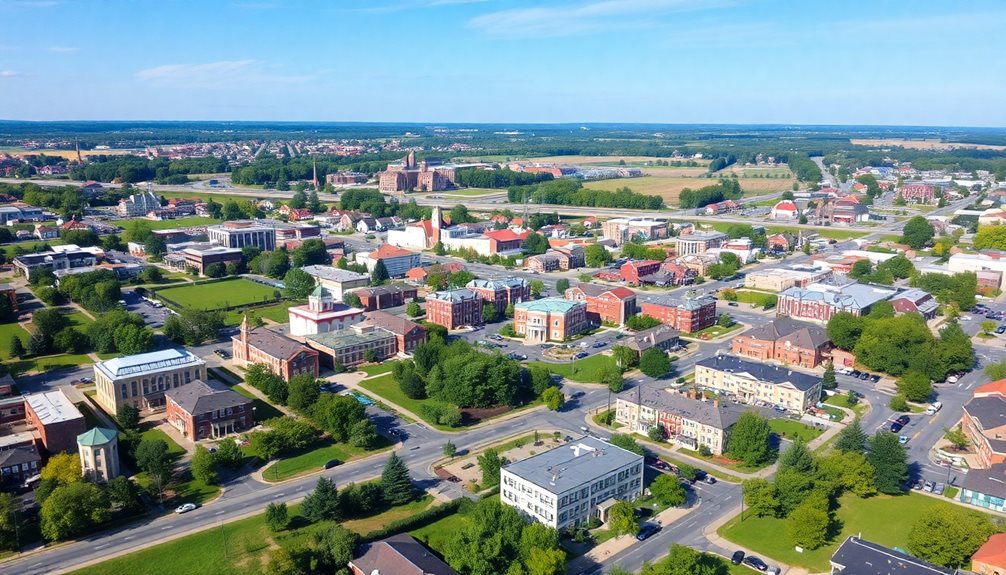
New Hope MN
New Hope, Minnesota, evolved from a farming community within Crystal Lake Township to a suburban city incorporated in 1953. Today, it has a population of around 20,000, with a diverse racial composition and a median household income ranging from $73,698 to $94,243. The city offers vibrant amenities, including parks and public transit, and community development initiatives enhance its appeal. Continuing to explore reveals how New Hope balances growth and community engagement.
Expert Highlights
- New Hope, MN, was part of Crystal Lake Township before its 1953 incorporation.
- Population is about 20,000 to 21,000 with diverse racial communities.
- Median household income is around $73,698 with an 8-11% poverty rate.
- Offers 18 parks and excellent public transit for residents.
- Features an aquatic center and golf course for recreational activities.
Historical Background

New Hope, Minnesota, has a rich historical background rooted in its formation as a distinct entity from neighboring areas.
Originally part of Crystal Lake Township, it evolved into a farming community with family farms in the early 1900s. As Minneapolis expanded, residential developments moved westward, leading to the incorporation of nearby Crystal in 1936.
The western portion broke away to form New Hope Township, but in 1953, it incorporated as a city to prevent annexation by Crystal and saw rapid growth thereafter. This transformation marked a significant shift from agriculture to residential living.
Today, New Hope's charms continue to attract residents seeking a welcoming suburban community.
Current Demographics

As of the present day, the demographics of this Minnesota city reveal a complex tapestry of ethnic backgrounds and socioeconomic conditions.
New Hope's population is around 20,000 to 21,000 residents, with a decline observed in recent years. The racial makeup includes a majority of White residents (59-61%), followed by Black or African American (24-27%), and Hispanic (5-7%).
The median age is approximately 39-41 years, reflecting a mixed age distribution. Median household incomes vary, with reported figures around $73,698, though poverty affects about 8-11% of families.
Located near charming Robbinsdale, New Hope shares the diverse cultural fabric that characterizes this region of Minnesota.
Lifestyle and Amenities

Incorporating the diverse demographic backdrop, New Hope, Minnesota, presents a vibrant lifestyle fueled by an array of amenities that enhance residents' quality of life. Amenities include parks, fitness facilities, and convenient public transit options. The city boasts 18 parks with diverse recreational activities.
| Amenities | Features |
|---|---|
| Parks | 18 parks available |
| Transit | Excellent accessibility |
| Fitness | Community gyms |
| Recreation | Aquatic center, golf course |
These features contribute to New Hope's appeal, offering a blend of leisure and convenience.
Development and Challenges**
While the city of New Hope enjoys numerous lifestyle amenities, its development initiatives and frequent challenges reflect a broader metropolitan context.
Through programs like the Scattered Site Housing Program, New Hope transforms distressed properties, enhancing neighborhoods and boosting property values considerably—some properties have tripled in value.
Over eight years, 25 properties were revitalized, impacting local tax bases and improving living standards. These efforts align with regional development goals, supporting diverse housing options and local economic growth.
Expert Final Thoughts
New Hope, Minnesota, has transformed considerably since its early days as a farming community. From being part of Crystal Lake Township, it became a distinct entity with its incorporation in 1953. Today, it offers a blend of residential living and community amenities, though challenges like population fluctuations and urbanization have shaped its development. The city continues to evolve, balancing history with modern needs.
